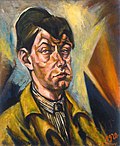File:Tihanyi Fülep Lajos.jpg

Original file (806 × 646 pixels, file size: 90 KB, MIME type: image/jpeg)
Captions
Captions
Summary
[edit]| Lajos Tihanyi: Portrait of Lajos Fülep
( |
|||||||||||||||||||||||||||
|---|---|---|---|---|---|---|---|---|---|---|---|---|---|---|---|---|---|---|---|---|---|---|---|---|---|---|---|
| Artist |
artist QS:P170,Q856707 |
||||||||||||||||||||||||||
| Title |
Portrait of Lajos Fülep |
||||||||||||||||||||||||||
| Object type |
painting object_type QS:P31,Q3305213 |
||||||||||||||||||||||||||
| Date |
1915 date QS:P571,+1915-00-00T00:00:00Z/9 |
||||||||||||||||||||||||||
| Medium |
oil on canvas medium QS:P186,Q296955;P186,Q12321255,P518,Q861259 |
||||||||||||||||||||||||||
| Dimensions |
height: 77.5 cm (30.5 in); width: 95 cm (37.4 in) dimensions QS:P2048,77.5U174728 dimensions QS:P2049,95U174728 |
||||||||||||||||||||||||||
| Collection |
institution QS:P195,Q252071 |
||||||||||||||||||||||||||
| Accession number |
70.152 T |
||||||||||||||||||||||||||
| Source/Photographer |
Fine Arts in Hungary: |
||||||||||||||||||||||||||
| Permission (Reusing this file) |
|
||||||||||||||||||||||||||
File history
Click on a date/time to view the file as it appeared at that time.
| Date/Time | Thumbnail | Dimensions | User | Comment | |
|---|---|---|---|---|---|
| current | 18:10, 22 February 2009 |  | 806 × 646 (90 KB) | Csanády (talk | contribs) | {{Painting | Artist = {{Creator:Lajos Tihanyi}} | Title = {{en|Portrait of Lajos Fülep}} {{hu|fülep Lajos portréja}} | Year = 1915 | Technique = {{Oil on canvas}} | Dimensions = {{Size|cm|95|77.5}} | Gallery |
You cannot overwrite this file.
File usage on Commons
The following 2 pages use this file:
File usage on other wikis
The following other wikis use this file:
- Usage on arz.wikipedia.org
- Usage on de.wikipedia.org
- Usage on en.wikipedia.org
- Usage on hu.wikipedia.org
- Usage on hu.wikibooks.org
- Usage on www.wikidata.org
Metadata
This file contains additional information such as Exif metadata which may have been added by the digital camera, scanner, or software program used to create or digitize it. If the file has been modified from its original state, some details such as the timestamp may not fully reflect those of the original file. The timestamp is only as accurate as the clock in the camera, and it may be completely wrong.
| JPEG file comment | TIHANYI Lajos
(1885, Budapest - 1938, Párizs) Fülep Lajos 1915 Olaj, vászon, 77,5 x 95 cm Magyar Nemzeti Galéria, Budapest Tihanyit saját vallomása szerint kizárólag a portré megkonstruálása érdekelte, melyhez mégis kivételes emberi szenzibilitás, együttérzés, sõt beleérzõ képesség is társult. Éppen Fülep Lajos, a Nyolcakkal baráti viszonyban álló mûvészetfilozófus állapította meg Tihanyiról, hogy a legortodoxabb cézanne-ista, aki ösztönös erõvel gyúrja össze a stíluselemeket és válogat a látványból saját festõi elveinek megfelelõen. Ugyanakkor rokona Kokoschka drámai expresszionizmusának is. Tihanyi az izmusok tanulságait ötvözõ, leginkább kuboexpresszívnek nevezhetõ formanyelven a kép festõi ritmikája érdekében deformálja az alakot. Torzítása mögött a homogén képi struktúra egyensúlyának megteremtése munkál. Ezt ismerte fel és értékelte a kortársak értetlenségével szemben Fülep Lajos, aki recenzióban reagált portréjára a MA kiállítása kapcsán. TIHANYI, Lajos (1885, Budapest - 1938, Paris) Portrait of Lajos Fülep 1915 Oil on canvas, 77,5 x 95 cm Hungarian National Gallery, Budapest Tihanyi said he was interested only in composing portraits which was accompanied by a unique human sensibility, sympathy and empathy. It was exactly Lajos Fülep, an art philosopher, who was a friend of the Eights, said that Tihanyi was an orthodox follower of Cézanne, and that he spontaneously integrated elements of styles and selects views according to his pictorial principles. He can also be linked to Kokoschka's dramatic expressionism. Tihanyi integrated lessons of various isms and deformed figures in cuboexpressionism for the sake of his pictorial rhythm. He destorts in order to balance homogeneous structure. Unlike his contemporaries, Lajos Fülep appreciated Tihanyi's art which he expressed in his critique on "Self-Portrait". Type: portrait Time-line: 1901-1925 Form: painting |
|---|

